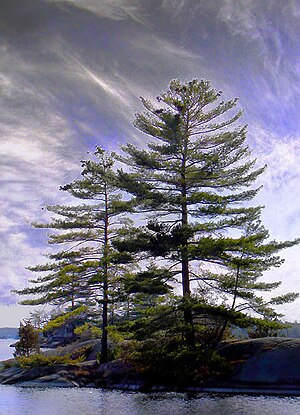 Image via Wikipedia
Image via WikipediaNot necessary laid back, but it is more of the undisturbed, regions; this is one where the nature can be best viewed as nature, without manmade structures to clutter up the sight, and jumble the scenery.
Be one with the creation, and feel the serene quietness of the undefiled ground.
Read on...
-----
Cottage country
Be one with the creation, and feel the serene quietness of the undefiled ground.
Read on...
-----
Cottage country
Summer time, and the living is easy in eastern Canada
IT'S dawn, and on a lake as flat as a mirror, the mist swirls and rises. It's so quiet you can almost hear the last of the night's stars winking out, or the sun's first light tickling the trees. Maybe a fish splashes somewhere, or a loon's haunting call wafts across the water. But mostly, it's as though the world has paused in waiting.
"I remember the silence being deafening," says Singaporean Karen Teoh, who first visited these lakes a few years ago. "It was even more beautiful than I'd imagined. Purer, if that makes sense. Asia is always noisy."
In the stillness, it's hard to believe that Canada's largest city - metropolitan Toronto, with its 6 million residents - is just an hour's drive to the south in the province of Ontario.
Welcome to cottage country, eastern Canada's summer playground. While Singaporeans define a weekend escape as boarding a plane to Phuket, a boat to Bintan, or trundling the family off to that chalet in Pasir Ris - for many Canadians, it means hopping in the car and driving to the family cottage.
Nor is it a new phenomenon. For more than a century, towns such as Orillia, Peterborough, Huntsville and Parry Sound have been storied gateways to the northern hinterland. Many family cottages have been passed down through the generations as heirlooms. Jill Trennum, who runs bed and breakfast Daytripper's Delight, says her property has been in her family for four generations, since 1905.
Ontario's cottage country comprises three main areas: The Kawartha lakes, Muskoka and the more rugged reaches of Georgian Bay further north. The Kawarthas are even linked by a long series of lift-locks, so that a yacht or houseboat can travel hundreds of miles through scores of lakes.
But don't expect the wild grandeur of the Rocky Mountains or the barren landscapes of the East. Cottage country is more of a gentrified wilderness, a cosy borderland where human comforts and wilderness coexist in friendly alliance.
That said, the scenery is unforgettable. Stretching pine forests, blue waters and countless islands. Stark, rocky landscapes of pink granite, sculpted by the glaciers that swept through here 14,000 years ago (and left all these lakes as a legacy.) It was enough to inspire Canada's most famous art movement, The Group of Seven, whose sweeping brush strokes and stylised scenes reflect these same landscapes.
"What struck me were the stunning views," says Lucretia Hung, a recent visitor from Hong Kong. "All those lakes make people feel the tranquility, peace, serenity and freedom of nature."
Tranquility. Peace. Solitude. These words frequently come up when describing the region. And wildlife, too, of course. Whether it is lakewaters that brim with fish, bird life, chipmunks on the deck or deer in the forests, meeting local animals is part of the experience.
"City people aren't used to the wildlife," says Jill Trennum, who has hosted guests from Europe and Asia. "Turtles basking in the sun, the splash of a beaver, loons calling at night. Our visitors love this nature, which they don't find back home."
Cottage country, however, is not just time out from hectic city life. There's a rich community of summer residents, many of whom come year after year. Marinas, general stores and island churches often serve as focal points. There's also no shortage of activities to keep families active: Canoeing and sailing regattas, art festivals, water-skiing, fishing, hikes and nature walks - not to mention cottage upkeep.
Fortunately, it's still possible for the passing traveller to experience this amiable wilderness. Alongside family cottages, venerable hotels - some a century old - dot the lakes. In those days it was trains and steamboats that brought city masses, escaping hot summer weather. Now, it's more likely to be a family van.
Times may have changed, but in cottage country, you can still get a taste of simpler days - a swim in a lake, paddling a canoe or catching a fish for breakfast before the sun fully rises above the trees.
Cottage checklist
Getting there: Reaching Toronto is easy. Airlines such as Emirates ($2,500) and Air Canada ($3,000) ply the route. The best option for reaching cottage country is to hire a car and drive, because public transport is limited. Ontario highways are safe and well-marked. You might also be able to work out an arrangement with your hotel. But be warned - driving times range from one to four hours.
Stay: Even without your own cottage, options abound. Venerable old hotels such as Muskoka's Windermere House (www.windermerehouse.com), Stony Lake's Irwin Inn (www.irwininn.com), or Georgian Bay's Killarney Lodge (www.killarney.com) offer lakeside luxury. Private bed and breakfasts are seasonally available through the area. The more adventurous can even rent a houseboat to travel at their leisure (www.houseboat.on.ca).
Do: Many lakeside hotels offer canoes and kayaks for guest-use, barbecues, guided nature tours and boat trips. Some also provide sailing and swimming lessons. Don't forget your fishing rod, too. Local towns and villages are worth visiting for antique and art-shops, farmer's markets and even fruit-picking. Most of all, cottage country is a great place to just kick back and relax.
From TODAY, Travel - Thursday, 29-April-2010
Cottage country
-----




![Reblog this post [with Zemanta]](http://img.zemanta.com/reblog_e.png?x-id=73f1a822-f48f-44d9-93f3-6d3a12c60d4f)















![Reblog this post [with Zemanta]](http://img.zemanta.com/reblog_e.png?x-id=5d864760-95fb-4611-87d2-94e5cdea3c69)








![Reblog this post [with Zemanta]](http://img.zemanta.com/reblog_e.png?x-id=1557c6a2-7b6c-4509-a22a-82b6eae53cdd)





![Reblog this post [with Zemanta]](http://img.zemanta.com/reblog_e.png?x-id=d77ab834-423e-4f1d-81c9-1d5f8b6ab7cf)